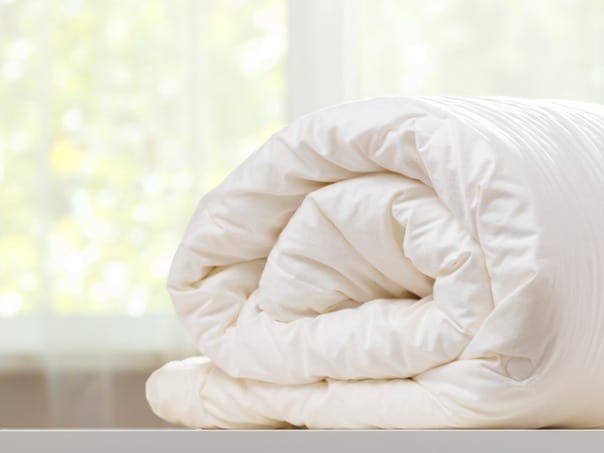Bedding
Published March 1, 2022
11 minWhat Is a Comforter?
A roaring success since their introduction in the 20th century, comforters are used by 58.3% of Americans today. Inaccurately called duvets in some countries, they were discovered to be in use in Swed

Table of contents
What is a Comforter?What is the difference between a Duvet vs Comforter?Comforter Sizes ChartComforter FillersPros and Cons of a ComforterHow Do You Choose the Right Comforter for you?Summing It UpFrequently Asked Questions
A roaring success since their introduction in the 20th century, comforters are used by 58.3% of Americans today. Inaccurately called duvets in some countries, they were discovered to be in use in Sweden around the mid 20th century and were sold soon after in Britain and the rest of the world. One of the warmest top covers available, comforters work well in cold weather and for sleepers who feel cold at night. In this guide, we take you through what they are made of, the different sizes available, and the difference between a comforter and a duvet.
What is a Comforter?
A comforter is two pieces of fabric sewn together to form a pouch that is stuffed with soft filling like wool, cotton, silk, or synthetic fibers like polyester. It is a quilted blanket that is used as a top sheet and forms part of a complete bedding set. Comforters are generally fluffier compared to a duvet. Duvets are traditionally filled with down or down alternatives and have a duvet insert that is used with a cover. You can notice the difference between most blankets by the number of layers. A comforter, with at least three layers, is heavier than a blanket which is generally a single layer of fabric. This makes them warmer than blankets but also a tough option to carry on trips or picnics. What Is a Comforter?: Everything You Need to Know 5What is the difference between a Duvet vs Comforter?
A comforter is a single piece of bedding whereas a duvet has a cover inside which it is slid. Duvets are easier to clean because you only wash the duvet cover instead of the whole set. The cover also protects the duvet for greater product longevity. Duvets often have clean and simple designs while a comforter can be more vibrant and change the look of your bed. A key difference that would make people choose duvets would be the fact that duvets do not hang from the side of the beds due to the specific size of the cover. Also, the covers are machine washable making duvets slightly easier to maintain.Comforter Sizes Chart
The best comforter brands will have comforters in almost all bed sizes including king, queen, full, or twin. However, sizes are not standardized and it may add to the overall size confusion.Unlike mattress sizes that are standardized, comforters can differ greatly in size from one manufacturer to another. This can add to the overall confusion and lead to unwanted and frustrating trips to the store, online or offline. This size chart below shows you a range of comforter sizes you can get for each bed size.| Size | Width (inches) | Length (inches) |
|---|---|---|
| Crib | 28 to 36 | 48 to 52 |
| Twin | 66 to 68 | 66 to 68 |
| Twin Xl | 68 | 90 |
| Full | 81 to 84 | 86 to 88 |
| Queen | 86 to 88 | 96 to 100 |
| King | 102 | 86 to 88 |
| California King | 107 to 110 | 96 to 98 |
Comforter Fillers
The filling of a comforter is usually made of cotton, wool, polyester, down, or a down alternative. The fillers act as an insulating material, their primary purpose being to keep you warm. These fluffy blankets are usually quilted to keep the stuffing evenly distributed and the stitch prevents the filling from clumping together. A cotton-filled comforter is the ultimate lightweight option for summers and warmer weather. Cotton is soft, breathable, highly absorbent, and hypoallergenic, meaning it won’t irritate the skin. It’s a perfect all-around option, fluffy but not as much as wool, down, or synthetic counterparts, and is 100% vegan.A down feather comforter is among the higher-end of your possible options. Down is fluffier and lighter than wool but provides similar warmth. Down filling is a natural product derived from white goose feathers; it cannot be machine washed and must instead be dry cleaned making it expensive to maintain.A wool-filled comforter offers unmatched warmth and has the added benefit of being naturally moisture-wicking. Derived from sheep, wool is thicker and heavier than other fillers and is a great choice for cold climates or for those who prefer maximum insulation. A silk-filled comforter boasts of luxury and opulence. Mulberry silk keeps you warm, is highly breathable, and has antibacterial properties, which makes it a top-tier choice for a top cover.Pros and Cons of a Comforter
Pros
- Plenty of patterns and style options
- You don’t have to wash them as often as blankets
- One of the warmest options available as a top cover
Cons
- Some aren’t machine washable
- They usually flatten over time
- Some have to be dry-cleaned, especially down-filled











